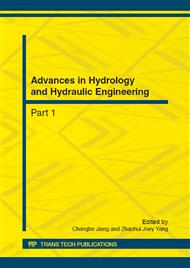p.899
p.904
p.912
p.917
p.922
p.928
p.934
p.942
p.947
Slope Stability Analysis of High Rockfill Cofferdam Considered with its Construction and Working Processing
Abstract:
Slope stability of high rockfill cofferdam is related not only to the structure and shape, material characterization, working characteristics of the cofferdam body, but also to the construction process. The influences of rock mechanics parameters are analyzed, which caused by the changes of structural stress state and transfusion equivalent stress in cofferdam construction process. Based on the slope stability strength reduction method, the slope stability analysis model of high rockfill cofferdam mirroring the construction process is established. At the same time, the parameter calculation methods are submitted and the correctness is proved. By the slope stability analysis of construction-running process, the results show that the most dangerous condition of cofferdam slope appears in the period of water level falling after pit excavation finished. With the increase of level falling speed, the position of the cofferdam dangerous sliding surface shifted from downstream slope to upstream slope. When the front weir level falling speed is determinate, the slope safety factor is appearing downward trend firstly and then upward trend, the minimum slope safety factor and the critical time is related with the level felling speed.
Info:
Periodical:
Pages:
922-927
Citation:
Online since:
October 2012
Authors:
Price:
Сopyright:
© 2012 Trans Tech Publications Ltd. All Rights Reserved
Share:
Citation:


